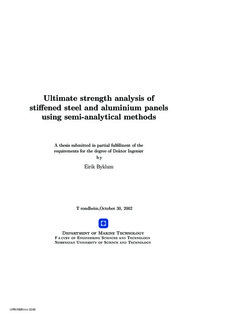| dc.contributor.advisor | Amdahl, Jørgen | nb_NO |
| dc.contributor.author | Byklum, Eirik | nb_NO |
| dc.date.accessioned | 2014-12-19T12:05:17Z | |
| dc.date.available | 2014-12-19T12:05:17Z | |
| dc.date.created | 2002-12-10 | nb_NO |
| dc.date.issued | 2002 | nb_NO |
| dc.identifier | 125048 | nb_NO |
| dc.identifier.isbn | 82-471-5524-9 | nb_NO |
| dc.identifier.uri | http://hdl.handle.net/11250/237651 | |
| dc.description.abstract | Buckling and postbuckling of plates and stiffened panels are considered. Computational models for direct calculation of the response are developed using large deflection plate theory and energy principles. Deflections are represented by trigonometric functions. All combinations of biaxial in-plane compression or tension, shear, and lateral pressure are included in the formulations. The procedure is semi-analytical in the sense that the incremental equilibrium equations are derived analytically, while a numerical method is used for solving the equation systems, and for incrementation of the solution.
Unstiffened plate models are developed both for the simply supported case and for the clamped case. For the simply supported case the material types considered are isotropic elastic, orthotropic elastic, and elastic-plastic. Two models are developed for analysis of local buckling of stiffened plates, one for open profiles and one for closed profiles. A global buckling model for stiffened panels is developed by considering the panel as a plate with general anisotropic stiffness. The stiffness coefficients are input from the local analysis. Two models are developed for combined local and global buckling, in order to account for interaction between local and global deflection. The first is for a single stiffened plate, and uses a column approach. The second is for a stiffened panel with several stiffeners.
Numerical results are calculated for a variety of plate and stiffener geometries for verification of the proposed model, and comparison is made with nonlinear finite element methods. Some examples are presented. For all models, the response in the elastic region is well predicted compared with the finite element method results. Also, the efficiency of the calculations is very high. Estimates of ultimate strength are found using first yield as a collapse criterion. In most cases, this leads to conservative results compared to predictions from finite element calculations. | nb_NO |
| dc.language | eng | nb_NO |
| dc.publisher | Fakultet for ingeniørvitenskap og teknologi | nb_NO |
| dc.relation.ispartofseries | Dr. ingeniøravhandling, 0809-103X; 2002:131 | nb_NO |
| dc.subject | Technology | en_GB |
| dc.subject | Buckling | en_GB |
| dc.subject | Ultimate strength | en_GB |
| dc.subject | Nonlinear plate theory | en_GB |
| dc.subject | Stiffened plate | en_GB |
| dc.subject | Postbuckling | en_GB |
| dc.subject | TECHNOLOGY | en_GB |
| dc.title | Ultimate strength analysis of stiffened steel and aluminium panels using semi-analytical methods | nb_NO |
| dc.type | Doctoral thesis | nb_NO |
| dc.source.pagenumber | 174 | nb_NO |
| dc.contributor.department | Norges teknisk-naturvitenskapelige universitet, Fakultet for ingeniørvitenskap og teknologi, Institutt for marin teknikk | nb_NO |
| dc.description.degree | dr.ing. | nb_NO |
| dc.description.degree | dr.ing. | en_GB |
